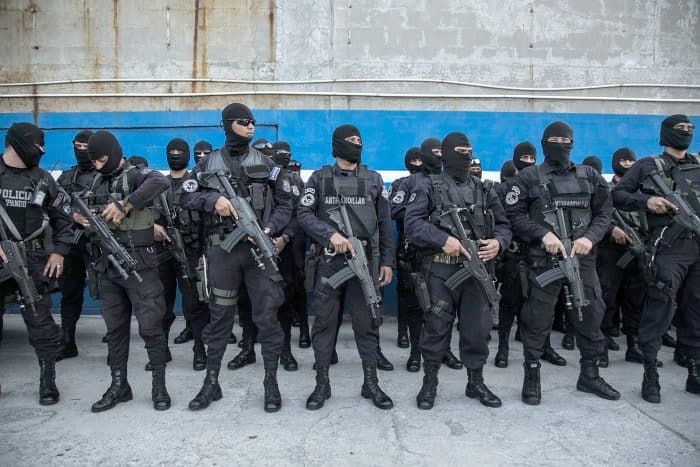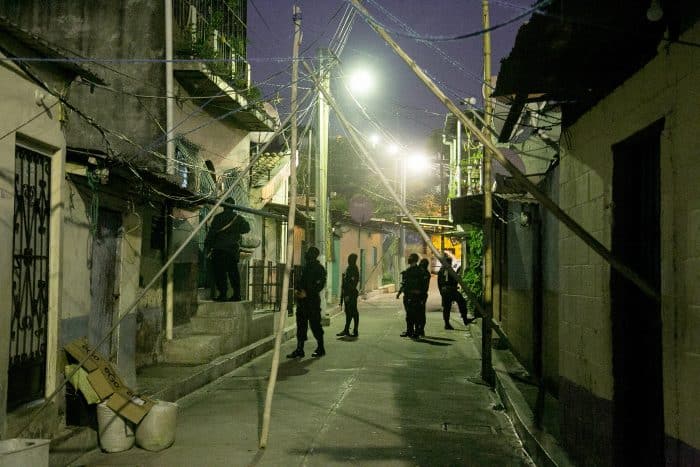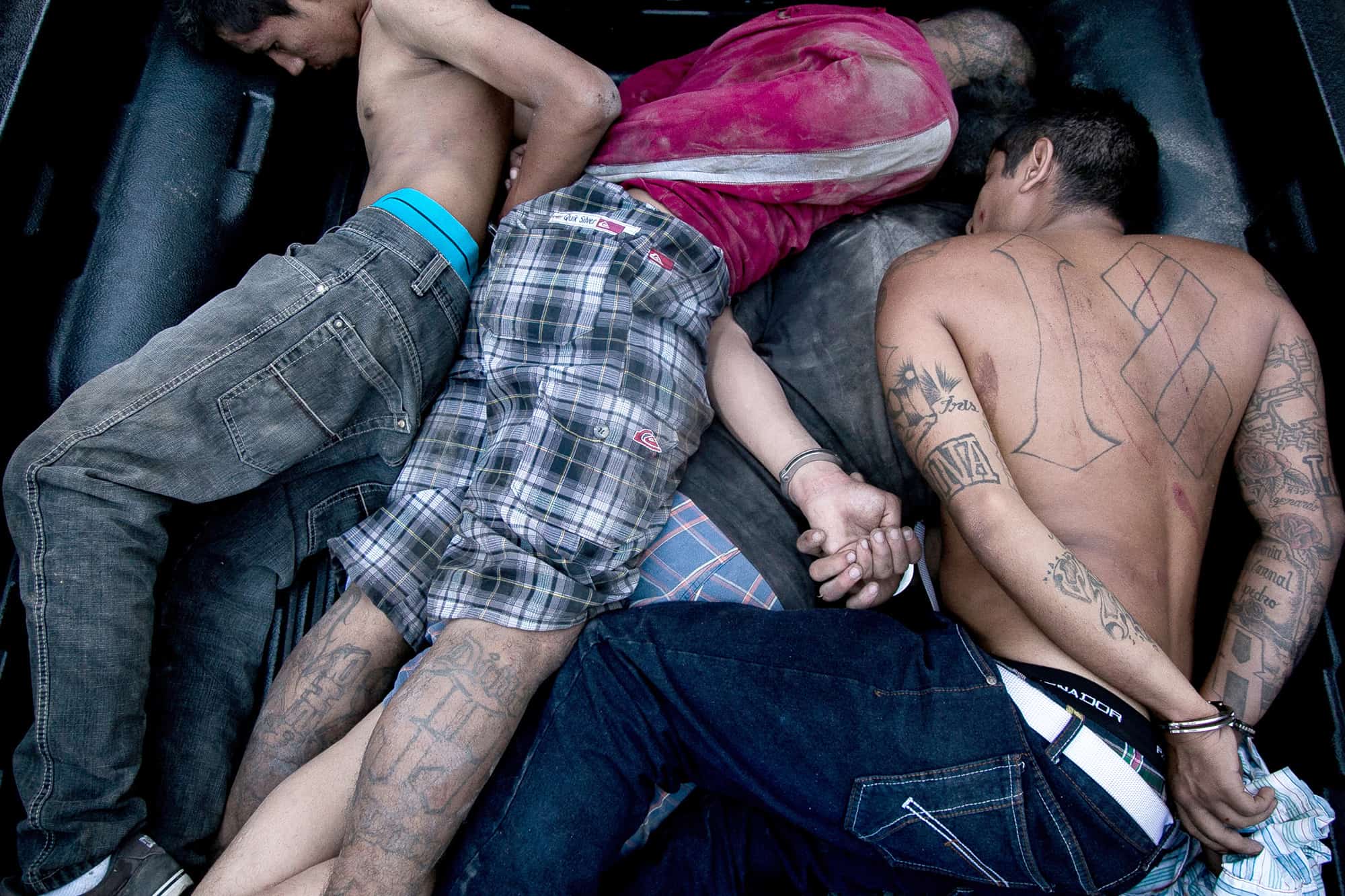See also: In San Salvador everyone has to pay the gangs
SAN SALVADOR, El Salvador — Most nights now, men in black masks are sweeping through this city, house to house, rousting shirtless boys from their mattresses, shining flashlights across their torsos, looking for tattoos.
The police officers rummage for drugs and guns but will settle for Nike Cortez sneakers — a gang favorite — or any symbol of affiliation, like a little grim reaper scribbled on a bedroom wall. Then it’s into zip-cuffs and down to the station, with maybe a shove or a twist of the cuffs on the way. Because for the 500 members of El Salvador’s anti-gang police force, this has become personal.
In El Salvador, the homicide rate has spiked to its highest level in a decade, putting the tiny Central American nation on pace to become the most deadly country in the hemisphere. Since a 2012 truce between the two most powerful street gangs crumbled last year, violence has surged. More than 1,800 people have been killed this year, including two dozen police officers, most slain while off-duty.
Amid a public outcry and mounting government pressure, El Salvador’s anti-gang police have ratcheted up their operations, killing suspected gang members and arresting more than 4,400 others this year. New laws have made it harder to investigate police violence. The country’s vice president, Óscar Ortiz, has said that police “must use weapons and should do so without fearing consequences for their actions.”
Within police ranks, there is both fear and law-and-order bravado, an edgy, confrontational climate that human rights groups say evokes memories of the brutal 1980s civil war.
On Thursday, after a ceremony to distribute new bulletproof vests to the force, police chief Mauricio Ramírez Landaverde vowed: “We cannot permit this situation; we will control it.”

Over the years, El Salvador has tried various iron-fisted security plans, but the gangs have become so pervasive that some consider them akin to a shadow government. So far, there is no sign the latest police crackdown is changing that.
On his laptop inside the fortresslike headquarters known as “the Castle,” police sub-director Pedro González, the leader of the anti-gang force, scrolls through maps and aerial photos illustrating the ever-shifting gang territory. Nearly the entire country is divvied up between the two main rivals, Mara Salvatrucha and the 18th Street gang. Both descended from Salvadoran immigrant gangs started decades ago in Los Angeles. Police say there are now more than 30,000 gang members inside and outside prison; other estimates put the number at twice that, or about half the size of the nation’s police force.
The gangs have diverse criminal interests — the drug trade, migrant trafficking, gun-running. A police study found that just in the few blocks of San Salvador’s historic center, gangs earned $100,000 a day extorting businesses, a vast sum in this poor country. The wealth attracts a flow of new recruits.
In 2012, the gangs negotiated a truce, blessed by the government and facilitated by the Catholic Church, that included transferring imprisoned leaders to less-restrictive jails, with access to family and phones, where they could keep contact with members outside and still run their operations. The murder rate plummeted.
After a little more than a year, the truce fell apart. The new president, Salvador Sánchez Cerén, a former leftist guerrilla commander during the civil war, opposes negotiations with the gangs. His government has transferred more inmates back to the maximum-security prison. Some see the surging death toll as a gang tactic to pressure the government; others contend that aggressive policing has provoked the gangs to lash out at officers, government officials and civilians. Police say a quarter of those killed this year are gang members, many slain by rivals, but others by police. (Figures on police killings are not broken out.)
The gangs issued a statement last month saying police are the most dangerous criminals and “what their actions are feeding is war.”
González, who didn’t support the truce, believes the gangs used that time to re-arm and consolidate power, and that they have been the aggressors.
“They gave the order to attack authorities of the system, the prisons, the prosecutors, police. To protest their decisions. This is why we have this quantity of deaths,” he said. “The gangs began to attack, and police have to defend themselves.”
González, 50, has served the state since the civil war, when he was an army captain trained at the School of the Americas in Fort Benning, Georgia. After two decades rising through the police ranks, and tutorials from the FBI and the Baton Rouge police, he knows crime-fighting theory. At his desk he flips through a 2002 study he wrote, explaining the virtues of a holistic strategy based on prevention, rehabilitation, finding a path for vulnerable youth back into the societal fold. He’s an affable man with varied interests, an amateur oil painter and evangelical pastor: He believes in second chances.
But his cellphone has other priorities. Juggling calls while steering his black sedan to an unmarked intelligence base, González learned that gang members were holding a man’s four children hostage. A few days before, during the year’s most violent weekend, a text message informed him that gangs were plotting attacks in the capital to avenge three comrades slain by his cops. Each day, an email appears with the year’s cumulative body count.
“With 22 deaths a day, you can’t think about the long-term. People are demanding answers,” he said. “If you have both cancer and a headache, you’ll deal with the headache now and worry about the cancer tomorrow. You have to treat the pain.”
A couple hundred of González’s foot soldiers stood in formation in a parking lot one afternoon last week. They pulled on their face masks and turned off their phones. The mission, known as Safe House, was to sweep a slum for suspected gang members.
“Be very careful to respect the rights of the people,” the commander told the men. “A policeman has to be professional. But he also has to be strict with the criminals.”
The force arrived in a warren of alleys known as Tutunichapa and started knocking on doors. A little girl shouted “Get out, police!” In the cinder-block shanties, the officers dug through cupboards and looked under beds. When they pulled out suspects, some with small quantities of marijuana, others with tattoos, residents gathered to watch. A grandmother was crying. One handcuffed suspect tried to comfort his relatives: “I’m a minor. It’s OK,” he said. “Three days, max.”
By the end of the operation, police had sat 14 people on the ground facing a concrete wall along a gas station parking lot, before taking them to the station for processing and to check for prior crimes. One officer, before leaving, punched a man in the back. His forehead smacked the wall. A shirtless, handcuffed man lying in an oil stain yelled at the officers: “This is my country. You are nothing.”

For some police, frustration is mounting. They get paid about $500 a month and want raises. Some don’t have proper uniforms. Citizens withhold information. Now that the police killings have risen, many live in fear. The last officer to die was a woman named Wendy Alfaro who was shot while buying tortillas with her daughter.
“We don’t have the freedom to go outside with our families,” said Freddy Rodríguez, a 38-year-old agent. “They’ll kill you. They know you and they’ll kill you.”
That night, the anti-gang police raided an apartment complex by moonlight, shooing away barking dogs and roosters. They interrogated an 18-year-old boy in his boxers who had been sleeping on a mattress with no sheets.
“You’re a gang member.”
“No.”
“A Mara?”
“Neither.”
An officer picked up a framed drawing. It depicted a swirl of demons, a joker’s face, a marijuana leaf, the phrase “Life is a dream.” The police said it was 18th Street gang iconography. An officer took the drawing outside and stomped it with his boot.
“My dad gave me that,” the kid said.
The aggressive posture of police and soldiers worries human rights groups in El Salvador. Jeanne Rikkers, who has worked on police and human rights issues for years in San Salvador, said that as she takes testimony from citizens about disappeared relatives or other abuses, “people are reporting things to you that sound like the ’80s.”
“It is a police force that is riddled with corruption and has a very strong tendency to abuse authority under the pretext of security,” Rikkers said. “The general impression is the police can do whatever they want.”
In his office, González, the anti-gang chief, mentioned that his father was a cacao and coffee farmer. When you work with your hands, he said, you get callouses, but police work can callous your heart. When he reads the daily death toll he thinks about the mothers. Families of gang members come to his church services, he said, and he tries to show them a different path.
But the political climate has changed.
“If these killings of gang members had happened five years ago these police would be in prison; if they happened two years ago, they’d be jailed, for violation of human rights,” he said. “The population supports these types of procedures. They are seeing that the aggressive behavior of the police keeps the gangs from growing.”
“You can’t let the gangs take over the state,” he said.
Gabriela Martinez contributed to this report.
© 2015, The Washington Post






